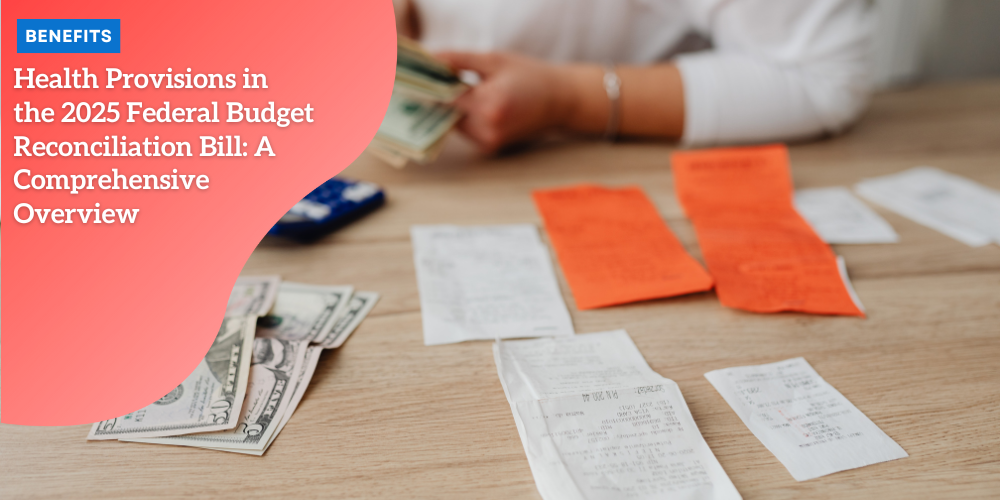Health Provisions in the 2025 Federal Budget Reconciliation Bill: A Comprehensive Overview
By: Lara Barbosa Posted in: May 25, 2025 Last Update: May 29, 2025

Key Changes to Medicaid, Medicare, Affordable Care Act, and Health Savings Accounts
On May 22, 2025, the U.S.
Anúncios
House of Representatives passed a landmark budget reconciliation bill that introduces extensive modifications to health-related federal programs.
This legislation notably reshapes Medicaid, amends provisions under the Affordable Care Act (ACA), and brings forth critical updates regarding Medicare and Health Savings Accounts (HSAs).
This article offers a detailed summary of the HSA-related elements embedded within the House-passed reconciliation bill, highlighting the legislative changes compared to the existing law.
Anúncios
The overview is based on the final amendments contained in the House Rules Committee Print issued on May 19, 2025.
Expansion of Health Savings Account (HSA) Provisions in the 2025 Budget Reconciliation Bill
Current Framework vs. Proposed Changes
Health Savings Accounts have been a pivotal tool for enabling individuals with high-deductible health plans to save pre-tax dollars for qualified medical expenses.
However, the new bill proposes significant expansions to what qualifies for HSA use, contribution limits, eligibility criteria, and account flexibility.
Anúncios

1. Inclusion of Select Sport and Fitness Expenses as Qualified Medical Care
Current Law:
HSAs can only be utilized tax-free for “qualified medical expenses.”
These traditionally encompass expenditures associated with:
-
Diagnosis, treatment, mitigation, cure, or prevention of disease.
-
Activities impacting the body’s structure or function.
-
Essential transportation directly tied to medical care.
-
Menstrual products have recently been recognized as qualified expenses.
Changes Under the 2025 Reconciliation Bill:
-
Select physical fitness-related expenses, including gym memberships and specific sport activities, will be reclassified as qualified medical expenses eligible for HSA payments.
-
To prevent excessive use, an annual cap is imposed: $500 for individuals with single coverage and $1,000 for joint filers.
Effective Date: January 1, 2026
Implications:
This change represents a progressive step in acknowledging physical fitness as a preventive healthcare measure.
By allowing HSAs to cover fitness expenses, individuals are incentivized to invest in healthier lifestyles, potentially reducing long-term healthcare costs.
2. Substantial Increase in HSA Contribution Limits for Eligible Individuals
Current Law (2025 Limits):
-
Individual coverage: $4,300 annual contribution cap.
-
Family coverage: $8,550 annual contribution cap.
Proposed Changes:
-
Contribution limits would effectively double to $8,600 for individuals and $17,100 for families.
-
Income-based phaseouts would apply:
-
Individuals with adjusted gross income (AGI) between $75,000 and $100,000 would experience a reduction.
-
Joint filers with family coverage earning between $150,000 and $200,000 AGI would face similar phaseouts.
-
Effective Date: January 1, 2026
Significance:
By increasing contribution limits, the bill allows more robust tax-advantaged savings for healthcare costs, empowering individuals to better prepare financially for medical expenses.
3. Eligibility for HSA Contributions Despite Spouse Holding a Health Flexible Spending Account (FSA)
Current Law:
-
Individuals cannot contribute to an HSA if their spouse has an FSA.
Changes Introduced:
-
Individuals will be allowed to contribute to an HSA even if their spouse maintains a health FSA.
Effective Date: January 1, 2026
Impact:
This provision increases flexibility for couples managing healthcare expenses through different tax-advantaged accounts, enabling broader access to HSA benefits.
4. Medicare Part A Enrollees by Age Can Continue HSA Contributions
Current Law:
-
Enrollment in Medicare disqualifies individuals from contributing to an HSA.
Bill’s Amendment:
-
Persons 65 or older enrolled only in Medicare Part A (hospital insurance) may still contribute to HSAs.
-
However, such individuals are prohibited from using HSA distributions to pay for health insurance premiums.
-
Distributions not used for qualified medical expenses will be subjected to the standard 20% penalty tax.
Effective Date: January 1, 2026
Interpretation:
This amendment recognizes the unique status of Medicare Part A enrollees and offers them continued opportunity to save for medical costs through HSAs.
5. Recognition of Individual Market Bronze and Catastrophic Plans as HSA-Qualified High Deductible Health Plans (HDHPs)
Background:
-
Bronze and catastrophic plans, offered in the individual health insurance market, have not been classified as HDHPs eligible for pairing with HSAs.
-
Bronze plans typically cover 60% of expected costs, with higher cost-sharing and lower premiums.
-
Catastrophic plans offer lower premiums with high deductibles aligned with ACA out-of-pocket limits ($9,200 individual in 2025, $10,150 in 2026).
Legislative Change:
-
Both bronze and catastrophic plans will be treated as qualifying HDHPs for HSA pairing.
Effective Date: January 1, 2026
Consequences:
This expansion enables more consumers purchasing lower-tier plans to benefit from HSA tax advantages, broadening accessibility.
6. Direct Primary Care (DPC) Arrangements Recognized for HSA Eligibility
Current Issues:
-
Some DPC agreements, where patients pay periodic fees for unlimited primary care services, are currently considered health plans.
-
This classification renders participants ineligible for HSAs.
Bill Provisions:
-
DPC arrangements with fixed fees capped at $150 per individual or $300 per family per month will not be considered health plans.
-
These DPCs must be limited to primary care, excluding:
-
Procedures requiring general anesthesia.
-
Prescription drugs, except vaccines.
-
Laboratory services uncommon in ambulatory care settings.
-
-
Fees paid to such DPCs are categorized as qualified medical expenses payable via HSAs.
Effective Date: January 1, 2026
Rationale:
This change allows patients to utilize HSAs for primary care-focused DPC services, promoting innovative care models without jeopardizing HSA eligibility.
7. On-Site Employee Clinics Offering Qualified Services Excluded from Health Plan Coverage Definition
Current Law:
-
Access to free or subsidized on-site employee clinics offering comprehensive care is considered other health coverage, disqualifying individuals from HSAs.
Modifications:
-
Clinics owned or leased by employers providing certain qualified services without comprehensive coverage will not be treated as health plans.
-
Qualified services include:
-
Physical exams
-
Immunizations
-
Over-the-counter medications and biologics
-
Injury treatments related to work
-
Preventive care for chronic conditions (per IRS definitions)
-
Drug testing
-
Hearing and vision screenings
-
Effective Date: January 1, 2026
Effect:
This provision encourages employer wellness programs and on-site clinics by allowing employees to retain HSA eligibility while accessing these resources.
8. Allowing Both Spouses to Make Catch-Up Contributions to the Same HSA
Current Law:
-
Spouses over 55 may each contribute an additional $1,000 as catch-up contributions, but cannot combine catch-up contributions into one HSA.
Proposed Change:
-
Couples over 55 can now pool catch-up contributions into a single HSA held by either spouse.
Effective Date: January 1, 2026
Benefit:
This modification enhances contribution efficiency and flexibility for married couples saving for healthcare expenses.
9. Health FSA and Health Reimbursement Arrangement (HRA) Fund Transfers to HSA Allowed Under Conditions
Present Restrictions:
-
Funds from health FSAs or HRAs generally cannot be rolled over into HSAs.
New Provisions:
-
Individuals newly enrolling in HDHPs can roll over existing FSA or HRA funds into HSAs.
-
Conditions include:
-
No HDHP coverage during the previous four years.
-
Annual rollover caps set at the employee FSA contribution limit ($3,300 for 2025) for individual coverage, doubled for families.
-
-
Post-rollover, other rules apply to remaining FSA or HRA balances.
Effective Date: January 1, 2026
Implications:
This offers a pathway for greater consolidation of healthcare savings and streamlines individuals’ ability to maximize tax benefits.
| 📌 Aspect | Current Law | New Provision (2026) |
|---|---|---|
| 💵 Reimbursable Expenses | Only after HSA is established | Also includes expenses from up to 60 days **before** HSA setup |
| 🗓️ Timing Condition | N/A | HSA must be set up **within 60 days** of HDHP activation |
| 📅 Effective Date | Not applicable | January 1, 2026 |
| ✅ Significance | Limits early medical cost relief | Enables tax-free use of HSA for recent medical costs post-HDHP enrollment |
Conclusion
The 2025 federal budget reconciliation bill introduces a transformative suite of modifications to the healthcare savings landscape, particularly through expansive reforms to Health Savings Accounts.
By broadening eligible expenses, raising contribution limits, enhancing spousal contributions, and allowing integration with innovative care models, the legislation aims to empower Americans with greater financial control over their healthcare spending.
These changes, becoming effective primarily in 2026, mark a significant evolution in federal health policy aimed at improving access, affordability, and flexibility for consumers navigating complex healthcare systems.





